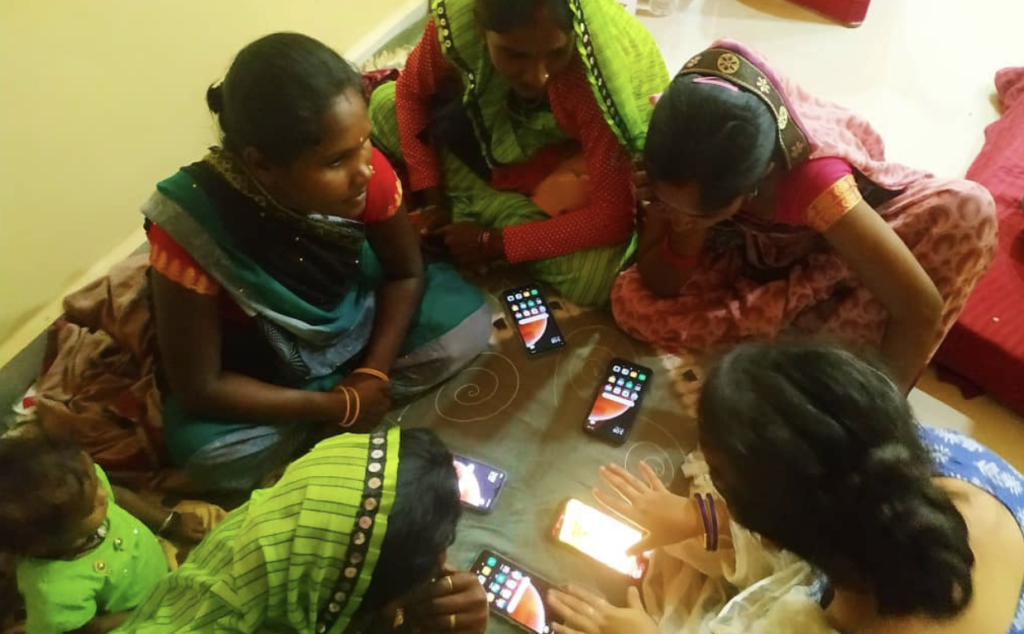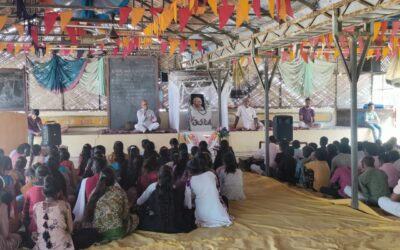Sajan Bai (on the left) glares as I (on the right) download WhatsApp on her phone
The popularity of smart phones has radically changed the way people communicate and gain information. With a single device, one can browse a random question on Google, text a classmate about their missed lectures, call a taxi to one’s doorstep and what not. The function of a phone has incorporated so much more than just the ability to call someone while attached to a cord. While the Gen-Z may not be able to remember a time where there were no smart phones, others have had to learn and adapt to using one and its seemingly endless functions. With the expanding dedication to technology and modernization, it seems that there’s something new you can learn every day.
Keeping this vision in mind, our team at Koshika held a meeting in Amanganj block of Panna, Madhya Pradesh for its team of health facilitators (all women) from the 10 select villages around Panna where Koshika runs health initiatives, primarily focusing on improving maternal and child health. The goal of this meeting was to equip these women with basic knowledge of using a smart phone so as to ease communication for themselves as well as with our team.
Upon reaching the venue, there was an ice-breaking session where the women were asked to recollect what they had been up to, in the past 6 months. Since this was the first time I was meeting them, my teammate asked me to introduce myself and also talk about why I joined Koshika. They reciprocated and gave me a brief about their line of work after joining the team. Post the introductory session, the smart phones were distributed to each one of them along with a new sim card.
The entire session was divided into six parts. It covered the most rudimentary understanding of a smartphone. Starting from inserting a sim card, switching on the phone, using the navigation and status bar, making calls and saving contacts, sending a text message, clicking photos and recording videos. We only partly introduced them to Google and talked a bit about what’s a browser.
They got it on saying how Google is like your mom. You can ask it anything and it understands if you make a mistake. Or how a browser is more like a car that you get into, to go to places and the website is like the destination.
Video walkthroughs were prepared in advance to assist their learning, although what truly came handy was breaking them down into smaller groups and making them practice each step multiple times, so as to get them comfortable with the functions. There was task-based learning where the facilitators were asked to make phone calls to each other, click selfies, and make a video of everyone in the meeting. They seemed to enjoy it thoroughly and the intimidation of technology started to phase out a little.
What got them comfortable was also the fact that smart phones allow you to choose a language that you’re comfortable with. A few guidelines were provided in terms of cyber security and overall care of their phones.
While conducting this workshop, I faced a few challenges. Firstly, since I was still an outsider, they were a little hesitant to speak to me directly and ask questions. For my lack of experience, I couldn’t gather if they genuinely understood what I was saying or were they just nodding along. Some of them were fast learners while the others were grasping the content at a moderate speed. While this is a natural phenomenon to occur with any audience, it posed as a huge challenge for me, mainly because this was the first time I was in a position of a trainer.
An imminent fear that we faced was that their husbands might take their phones away or sell them for money. In this regard, I personally spoke to them about why we are doing what we are doing and why having a smartphone is a better deal than instant money. In the upcoming meeting, our agenda is to revisit what was taught and to introduce new features like surfing on YouTube for videos, making use of Google for day-to-day enquiries, and doing transactions via apps like Google Pay.
I feel the women are smart enough to navigate it themselves and the next time we meet, who knows they’ll surprise us by asking us our Instagram handles!

The question we finally need to ask is what do smart phones mean to our community. Surely, the immediate benefit is that they are well-equipped to communicate with us and others. Along with streamlined communication, comes the fact that their agency will probably go up, which in turn will lead to a boost in their self-confidence. The phones can also be used to strengthen their already existing skills. One of the facilitators mentioned her keen interest in stitching and pointed out, “Main ab phone ke zariye videos dekh ke aur bhi acchi silai kadhai seekh sakungi”.
Another motive of getting phones for the health facilitators was to set up a satellite clinic in the near future. The aim of this clinic would be to provide health services to local residents in rural areas who live far away from medical facilities. Kamla Bai, from Khamri village, was extremely happy about the fact that she’ll be able to send pictures and videos of patients and communicate with our team for urgent medical help. She really enjoyed the voice note feature and the phone’s inbuilt flashlight also excited her.
Of course, the brand new gizmos can be overwhelming at first but the women’s attitude towards this initiative is inspiring. I can only hope that in the coming time, they use the technology to solve, if not all, then a few of the inconveniences they have to deal with, everyday.



Wonderful! Do tell us what new things the health facilitators did with their smartphones 🙂
Wonderful! Do tell us what new things the health facilitators did with their smartphones 🙂